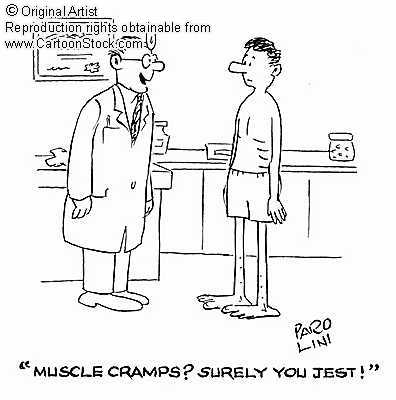
A muscle cramp, technically, occurs when your muscle tightens and shortens causing a sudden severe pain. Muscle cramps generally result from overexertion and dehydration. When you don't have enough fluid in your system, it leads to an electrolyte imbalance that causes your muscles to cramp up. Electrolytes are minerals such as sodium, magnesium, calcium and potassium that help the cells to function normally. An imbalance occurs when we have too much or too little of one or more electrolytes in our system. The main electrolytes affecting muscle cramping are potassium, sodium and calcium.
Cramps may also occur after inactivity, such as sitting too long in one place without moving a muscle. Sometimes you can even get a cramp when you're just lying in bed, though researchers cannot define a cause.
Most often people get cramps in their calves, however, you can also get them in your thighs, feet or just about any muscle. Cramps can be eased by a few simple methods. First, relax the tightened area. You should gently massaging the area that's cramped, whether it's a crick in your calf from over exercising or a spasm in your feet. Second, stretch the muscle out slowly and gently, as long as you don't feel pain. For calf cramps, do a wall stretch. Stand about three feet away from the wall, with your knees straight and your heels on the floor. Lean into the wall, supporting yourself with your hands. You will feel the stretch of your calf muscles. Hold for 60 seconds and repeat three times.

You should also make sure to drink plenty of fluids. If you get muscle cramps after exercise, drink water or a sports drink or juice to rehydrate and restore your electrolyte balance. Most of the time water will be sufficient to rehydrate you, however, you are then better off choosing a sports drink containing electrolytes.
You may also undo a cramp with ice. Ice is both a pain reliever and an anti-inflammatory. Try massaging the area with ice for no more than ten minutes or until the area is bright red, which indicates that blood cells have returned to heat the cramped muscle. If ice is too uncomfortable, try heat. Heat improves superficial blood circulation and makes muscles more flexible, so some people find that heat is more soothing for muscle cramps than ice. Try a heating pad for 20 minutes at a time or even a warm shower or bath. Make sure to massage the muscle with your hands following ice or heat.

1 comment:
Mine is always in calf area. And I find it really hard to sleep whenever my muscle cramps. I was advised to take a lot of water and always have banana on every meal. Is that because banana is rich in potassium?
muscle cramps
Post a Comment